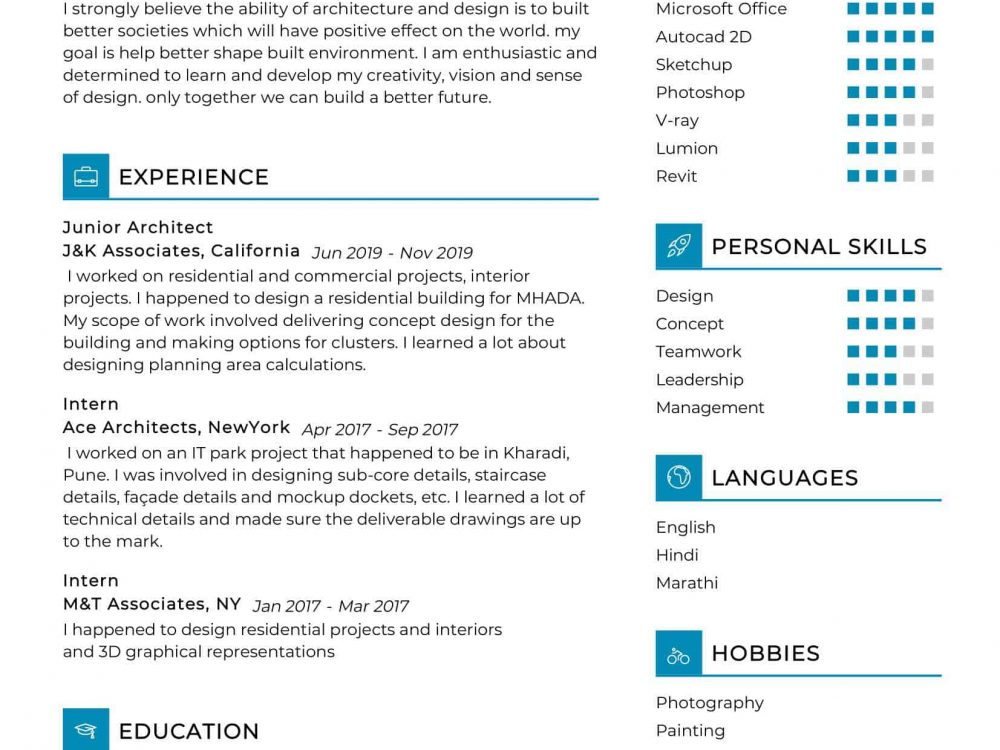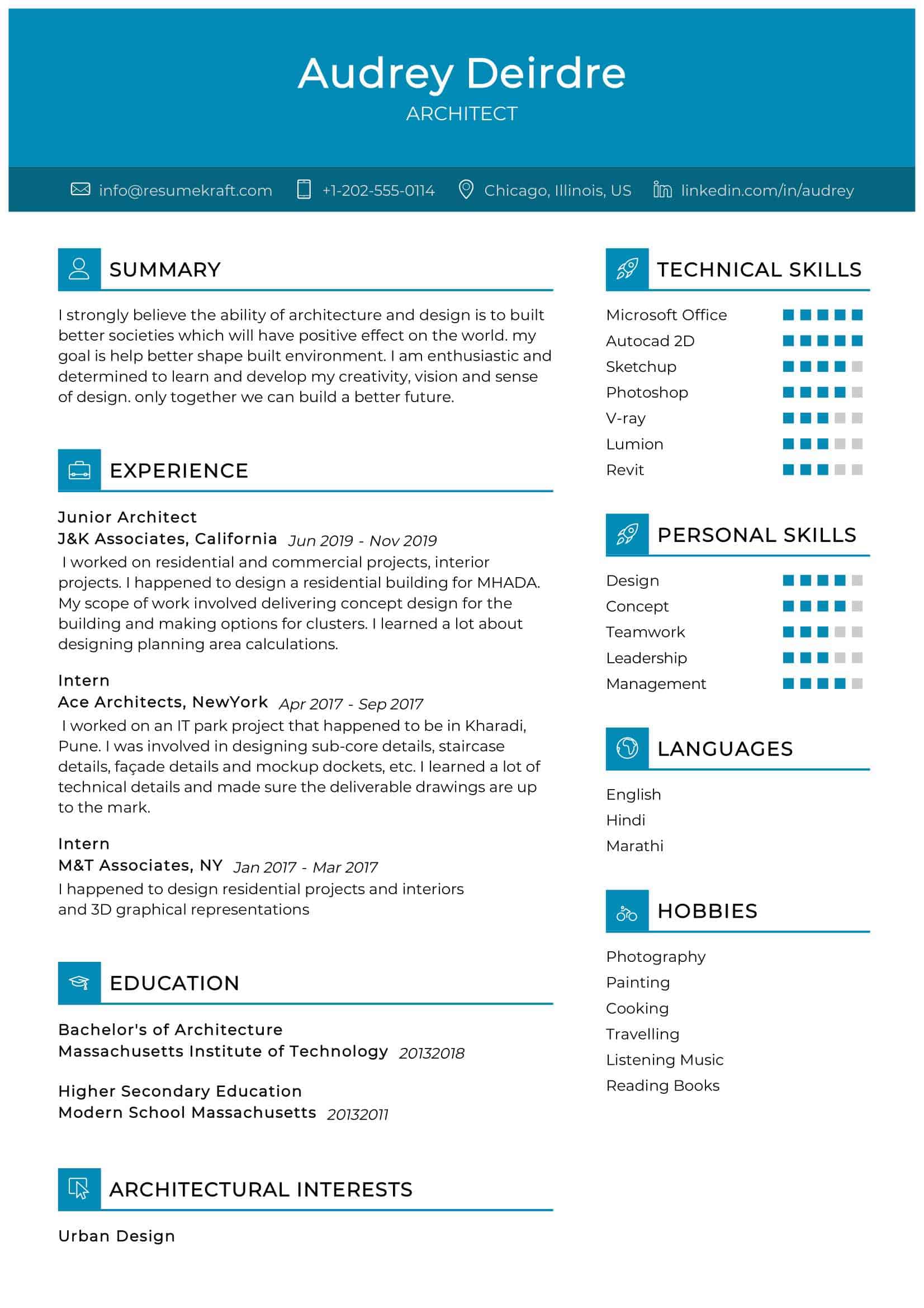Are you an Architecture by profession and looking for an exciting career? We have good news for you! use our professional Architecture Resume Sample. You don’t have to start writing from scratch. Just click “Edit Resume” and modify it with your details. Update the template fonts and colors have the best chance of landing your dream job. Find more resume samples.
Architecture Resume Sample
Audrey Deirdre
Architect
Summary
I strongly believe the ability of architecture and design is to built better societies which will have positive effect on the world. my goal is help better shape built environment. I am enthusiastic and determined to learn and develop my creativity, vision and sense of design. only together we can build a better future.
Skills
Personal Skills
Work Experience
Junior Architect
J&K Associates, California
I worked on residential and commercial projects, interior projects. I happened to design a residential building for MHADA. My scope of work involved delivering concept design for the building and making options for clusters. I learned a lot about designing planning area calculations.
Intern
Ace Architects, NewYork
I worked on an IT park project that happened to be in Kharadi, Pune. I was involved in designing sub-core details, staircase details, façade details and mockup dockets, etc. I learned a lot of technical details and made sure the deliverable drawings are up to the mark.
Intern
M&T Associates, NY
I happened to design residential projects and interiors and 3D graphical representations
Education
Bachelor’s of Architecture
Massachusetts Institute of Technology
Higher Secondary Education
Modern School Massachusetts
Languages
- French
- English
- German
- Chines
Career Expert Tips:
- Always make sure you choose the perfect resume format to suit your professional experience.
- Ensure that you know how to write a resume in a way that highlights your competencies.
- Check the expert curated popular good CV and resume examples
Architecture Resume with Writing Guide
Career advancement is tricky for architects, but this doesn’t mean that you can’t make your career dreams a reality. However, it’s quite difficult to land any job if you lack the skills to represent your professional qualifications in a clear and convincing manner. That’s why today we want to give you some pointers about how to write the perfect Architecture Resume.
You might have heard horror stories from friends or family members who lost out on their dream job because of an unattractive resume that didn’t get them noticed.
Architecture Resume Writing Guide:
- Your resume should be clean, free of unnecessary content, and well organized.
- Your resume should be easy to read and well-presented, with consistent fonts and formatting.
- Your resume should be a maximum of three pages in length.
- Your architecture resume should list your most relevant experience first. This is best achieved by putting your most recent positions at the top of the page and then moving downward chronologically through your positions over time, with projects listed in reverse order from latest to earliest (i.e. most recent project first).
- Your resume should include information about your education, professional licenses, honors and awards. This helps the reviewer to determine if you have the educational background to do the job.
- Your resume should include a brief description of your skills and achievements relevant to the position for which you are applying. It is not necessary to reiterate every skill or experience that you possess; bullet points are more effective than paragraphs for describing these attributes.
- Your resume should end with a summary statement briefly describing your experience and achievements, as well as touching on any additional relevant information.
- Your skills should be divided into several groups, such as design, project management and leadership. This allows you to list all of the different elements of your career in a simple manner so the reader can quickly decide what kind of position they are interested in from the beginning of your personal history.
- Your design resume should include a section for each of your education and career experiences. This allows the reader to quickly see what your design experience relates to.
- Your project management resume should list all of the projects you have managed in reverse chronological order starting with the most recent project and working backward toward earlier projects, with their dates and a brief description of each included as part of your summary statement.
Architecture Responsibilities:
- Identifying and investigating existing conditions and potential problems.
- Preparing drawings, blueprints, sketches, and presentations.
- Initiating project proposals by analyzing client needs, preparing cost estimates, and supervising all phases of design.
- Managing the project through all stages of development from concept to completion including contractor coordination to ensure compliance with building codes and operational requirements for function and performance.
- Preparing design documents such as project scope of work, contract terms, and conditions, bid packages, and specification documents.
- Interpreting codes and ordinances relevant to a project and ensuring that construction complies with them.
- Overseeing the development of working drawings, bidding packages and construction documents.
- Providing technical support for the facility as it is being used during its early stages of occupancy by contractors or other consultants.
- Preparing periodic progress reports for clients on different aspects of a project.
- Supervising construction of the facility at all times to ensure compliance with codes and regulations.
- Reviewing construction documents to ensure that they meet specifications and are complete.
- Providing information about the project and its progress to clients, potential investors, or other advisors, such as lawyers.
Top 10 Must-have Architecture Skills:
- Good user of 3D modeling software.
- Good attention to detail with drawings and renderings.
- Research of the architect’s job requirements with the client’s goals in mind.
- Communicate with clients in a professional and constructive manner, taking into account that the style may be different from yours.
- Ability to make creative suggestions and drawings for improving areas of the design.
- Ability to work in a team, representing your colleagues’ ideas and making compromises where appropriate.
- Knowledge of CAD (Computer-aided design) software.
- Knowledge of computer hardware and its applications.
- Ability to quickly learn new techniques and skills in order to adapt to the periodic changes and new trends in Architecture.
- Ensuring that architectural design is built according to the brief, site, budget, user requirements and aesthetic guidelines in accordance with Building Regulations and Standards set by the government.
Tips to write an Architecture Resume Summary:
- Use a two-page resume if you have at least 7 years of work experience.
- Emphasize pertinent details that are related to education and professional history.
- Use the reverse chronological order in writing, with the most recent job first.
- Estimate your salary for each position, or leave the space blank if it is not applicable or confidential information.
- Leave out irrelevant jobs or positions to keep your resume focused and relevant on what you want to be highlighted specifically in your career profile.
- In some cases, make sure to add a list of references (if applicable), but it should not take up a lot of space on your resume.
How to write an Architecture Resume with No experience:
- Research Industry
- Create and Draft
- Write the Objective Statement
- Create the Professional Experience Section: sources, titles, projects, clients – keep it brief!
- Create the Accomplishments Section: summarize achievements
- Write the Presentation Skills Section
- Write the Education Section
- Create the Work Experience Section [keep it short]
- Write the Awards and Honors Section
- Create the Skills Section
- Create the References Section
- Create the Contact Information Section: Personal information, address, phone number, social media, email address
- Name/callout for resume
- References for resume
- Resume cover letter examples
How to write an Architecture Resume Cover Letter:
- Think about your resume and cover letter as a potential employer first reads the document.
- Start by summarizing what is most important about you in bullet points:
- Design a cover letter that highlights your relevant experience (relevant to the architecture of course, not just general skills) and skills.
- Write the name of the person you are writing to in your cover letter so readers know whom to contact or contact them directly to get a response.
- Include an interview request in your cover letter.
- Do not ask for a job over the phone or send an email with the cover letter attachment. Merely call or email them and ask them if they can take a few minutes to discuss your resume and if you are selected to interview. If you are not asked to interview, do not conclude that means you have been passed over! Some people will choose not to interview anyone they have found through resume posting sites but will contact those who reach out to them by phone or email.
Key Takeaways:
- There are many samples of architecture resumes available for inspiration: Look online, talk to your academic advisor, or go to a professional networking event.
- A key aspect of creating a well-written resume is making the application as specific as possible: Include the name of your school and degree program (e.g., Bachelor of Architectural Studies at Pratt Institute).
- Tailor your resume to each job you apply for: If you’re applying for a summer internship, focus on design studios and leadership positions instead of classes and research.


